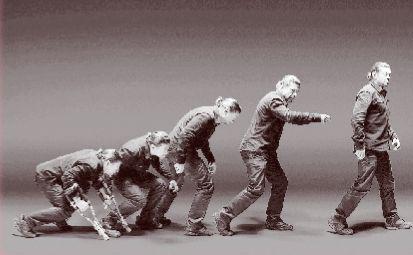安迪·瑟金斯:表演捕捉第一人
2013-07-09byDaveDavies
by Dave Davies
每当我们谈及电影制作时,视觉特效部门总是处在从属的地位,特效演员总是有点低人一等的感觉。但在21世纪初,有一个演员凭着一套电影巨作中的一个非人角色打响了名头,将原本不受重视的电脑特效技术一步步推向幕前——
Actor Andy Serkis has appeared in more than 30 films, but you wouldnt recognize him in some of his most 1)celebrated roles. When he played King Kong in the 2005 remake and the 2)tormented creature Gollum in The Lord of the Rings series, he appeared not as himself but as a computer-generated image.
Dave Davies (Host): You were filming that scene; youre there covered in a 3)Lycra suit, I guess, with these markers all over your face and a camera in front of you to capture this motion which will later be reproduced with the animation.
Serkis: Yeah, absolutely. I mean, in the same way that I would if…I was in a costume and doing the same thing. The…the process of performance capture really is 4)transparent now. That enables you to completely, emotionally connect with your fellow actors and completely play the scene in 5)entirety, and…and it will have an emotional 6)resonance and a reality and a…a connectiveness that…that you couldnt possibly get if two actors were working in separate volumes.
Davies: And you also played King Kong in the 2005 remake there…where you had to, 7)in effect, express this emotional relationship between a 25-foot 8)ape and Naomi Watts. And what…youre known for very 9)rigorous preparation for your roles. Im wondering, kind of, what it does to your head to…to be in the 10)mentality of an ape for weeks or months at a time.

Serkis: I mean, certainlyphysically, it…it 11)takes its toll. After Kong, my…my 12)knuckles have never really recovered because I used…I had to wear, you know, every single day, I had to wear very, very heavy weights on my 13)forearms…or around my hips and around my ankles to get the sense of size and scale of the movement of the character.
That was another very challenging, physical and, you know, emotionally connective role. But it does leave you…you know, it does…you know, theres always a 14)decompression period after playing any…really any role that I…I get into because I…I take it very seriously, and…and emotionally, youre tricking your mind and body into these situations. You know, you are telling your body that you are this thing and that youre feeling these thoughts and that you are experiencing these experiences. So…so it does always take time to kind of…to come out the other end.
Davies: You didnt go home and stand on the dining room table and beat your chest in front of your wife and children?
Serkis: Im sure shed say that I did, actually.
Davies: Well, we have to talk about Gollum, your 15)portrayal of the creature in The Lord of the Rings films. This is really an amazing effect. And tell us about getting the voice. Is your voice 16)enhanced in any way, or is that just you?
Serkis: No, no, that…thats just my voice.
Davies: Wow!

Serkis: And the…the voice was created through trying to find…you know, Im not like a voice…like a voice actor, 17)per se. I dont just do voices. It only comes through character and through acting. And for me, its linked entirely to 18)physicality and through, you know, centering an emotion around a voice.
So…so Gollum, he…he feels very guilty about murdering his cousin, and a lot of his guilt is trapped in his throat. And hes called Gollum—Tolkien calls him Gollum because of the way he sounds. So I had to find a voice that sounded like someone golluming.
Davies: Now, maybe this would be a good moment to talk about, you know, performance capture technology and how its changed because I gather when you did that role, Gollum, its different than in Rise of the Planet of the Apes. Its more 19)sophisticated.
Serkis: Performance capture then took a big leap and took center stage in films like obviously Avatar, where youve got 20)virtual production, where the whole shoot is basically taking place in a m o t i o n - c a p t u r e studio, and you have 21)multiple actors acting with each other using this technique.
With Rise of the Planet of the Apes, this is the first time were moving out of a motion-capture studio and into the real world, where both the actor is being filmed using film camera, and the performance-capture actor is being film using the performance-capture camera so that, as I say, theyre both 22)intrinsically linked in the moment. Davies: Now, there was a debate about whether you should have gotten an Oscar 23)nomination for Gollum. 24)Modesty aside, what do…what do you think about the arguments for recognizing a performance-capture role like this and giving it kind of all of the recognition that other actors get with the Academy?
Serkis: I mean, my…my take on it is…and having worked in it for some years now, is that acting is acting, that performance is a performance.
Davies: I do sometimes wonder if you dont have an agent whos telling you, “Andy, you need to get some roles where people see you, dude.”
Serkis: (laughs) I…you know, it…its probably taken about, you know, five minutes to understand why I do it. I…I do a lot of…you know, I want to go back and do theater and, you know, there are other live-action roles that I want to play. But I never really draw a distinction between the two. I dont…I dont see a difference between playing a performance-capture role and a live-action role. Theyre just characters to me 25)at the end of the day, and Im an actor who wants to…to explore those characters in…in fantastically written scripts. The only…the only 26)caveat is…is a good story, a good character.
演员安迪·瑟金斯参演过三十多部电影,但你无法从一些最著名的角色身上认出他来。当他在2005年的翻拍电影中饰演金刚,以及在《指环王》系列中饰演痛苦的咕噜姆时,我们看见的不是他的真面目,而是电脑合成的形象。
戴夫·戴维斯(主持人):你在拍摄那一幕,你在那儿,穿着一件莱卡紧身服,我猜你的脸上还贴满了标记点,面前的摄影机在捕捉这个动作,随后再进行动画加工。
瑟金斯:没错,就是这样。我的意思是,这是同样的方式,就像我要……就像我穿着戏服一样,做的是同样的事情。表演捕捉这一过程如今已经透明化了,让你可以和其他演员在情绪上彻底同步,让这一幕的表演更有整体性……它能带来情感上的共鸣,也更真实,还能产生一种联动性……如果两个演员在不同的部分各自拍摄,你不可能得到这样的效果。
戴维斯:你还在2005年的翻拍电影中饰演了金刚……事实上,你得表现一只25英尺(7.62米)高的巨猿与娜奥米·沃茨之间的感情。而……众所周知的是,你会为自己的角色进行严格准备。我想知道这对你的脑子会有什么影响……你每次要连续几周或者几个月地保持那种思维方式呢。
瑟金斯:我的意思是,身体上肯定有一定影响。拍完金刚之后,我的指关节没 能彻底好起来,因为我曾……我必须穿着,你知道,我每一天都必须在前肢上加上非常重的负重物……又或者加在我的臀部和脚踝,才能体会到这个角色动起来时那种庞大笨重的感觉。
那是另一个极具挑战性的角色——在体能上不轻松,你知道,情绪还要入戏。但它确实会让你……你知道,它……每当演完任何一个角色,我总是需要一个减压期,因为我对表演非常认真,而且从感情上来说,你要让自己的脑子和身体完全代入这些角色。你知道,你要告诉自己的身体,你就是这个生物,这就是你的想法,这就是你的经历。所以我总要花点时间才能从戏里走出来。

戴维斯:你该不会回家之后还会跳上饭厅的餐桌,在你的妻子和小孩面前拍打胸膛吧?
瑟金斯:她确实说我真的这么做了。
戴维斯:我们得聊聊咕噜姆——你在《指环王》电影中饰演的那个生物。那效果真是太棒了。和我们说说他的声音。你的音调经过任何拔高处理吗,抑或是那就是你的声音?
瑟金斯:不不,那就是我的声音。
戴维斯:哇!
瑟金斯:创造出那个声音是通过寻找……你知道,我不是一个……我本身并不是配音演员。我不是单纯配音,这声音源自角色本身以及我的演技。对我来说,这完全取决于角色形态,以及——你知道,通过围绕声音的情绪来表现。
所以咕噜姆他……杀害自己表弟这件事让他很有负罪感,而这些罪恶感基本都卡在他的喉头。他被称为“咕噜姆”——托尔金给他取名咕噜姆,正是因为他说话含混不清。所以我要找到一种声线,听起来就像“咕噜咕噜”一样。
戴维斯:现在也许正是时候了,你知道,谈谈表演捕捉技术是如何演变的,因为你在演咕噜姆时的情况和《猩球崛起》并不一样。现在更先进了。
瑟金斯:当年的表演捕捉实现了大跃进,在《阿凡达》这样的电影中俨然成了主角——那些电影有虚拟制作部分,整个拍摄过程基本上都是在动作捕捉摄影棚完成的,众多演员用这个技术一起拍戏。
而在《猩球崛起》中,我们第一次离开动作捕捉摄影棚,第一次在真实情景中拍戏,一般演员用普通摄影机拍,表演捕捉演员用表演捕捉摄影机拍——就像我刚才所说的那样,双方一下子就找到感觉了。

戴维斯:那时人们都在争论你是否应该凭借咕噜姆提名奥斯卡。我们就不客套了,你怎么想……表演捕捉角色应该像其他演员一样获得奥斯卡承认,你对这个争论是怎么想的呢?
瑟金斯:我的意思是,我对此的看法是……我已经在这一行干了这么多年,我觉得演戏就是演戏,表演就是表演。
戴维斯:我有时会想,难道没有经纪人对你说:“安迪,你要接几个人们能看到你真面目的角色,老兄。”
瑟金斯:(笑)我……你知道,人们大概要花上五分钟才能搞懂我为什么干这行。我有许多……你知道,我想回去演戏剧,我想演其他真人角色。但是我从来没有在这两者之间画下分界线。我觉得扮演一个表演捕捉角色和真人角色没什么不一样。说到底,这两者对我来说都只是角色罢了,我是一个演员,只想进一步了解那些有精彩剧本的角色。我唯一的要求就是一个好故事,以及一个好角色。

